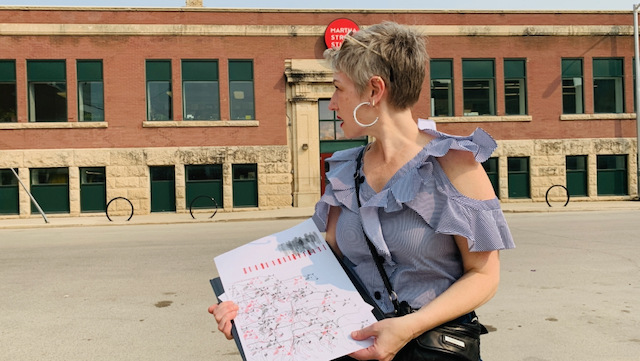
I first learned of Miriam Rudolph in 2019, at a CTMS conference. That year the theme had been Mennonites and Anthropology. She presented her paper called disPOSESSION: Exploring Mennonite and Indigenous Land Usage in Paraguay through Art. I find her work to be important, deep, fascinating, and she explores something I know very little about.
So, I was excited to check out her exhibit at Martha Street Studio in Winnipeg!

I found myself really wishing I could take hold of Rudolph’s work and bring it home and think on it some more. And then I saw that this is all bound up in a beautiful, limited-edition book and I could purchase it!

It is a beautiful hardcover in black, with English on one side and Spanish on the other.
I’m so glad I can read the artist statement whenever I want now. In it she explains this work layers the narratives of the Enlhet and Enxet indigenous people, Anglican missionaries and Mennonite settlers. Each image she has created is a layering of these differing narratives which live beside the image.

The first image I’m confronted with is of the jungle and artefact boxes. This makes sense alongside the artist statement — whose artefacts do we keep and which stories do we tell? And how does that shape us all as we move forward? Are there any stories we are missing?
We know the answer.
These are chilling narratives, wherein we can see in the settler and missionary diarist’s own words that they viewed the Enlhet and Enxet people as little more than labourers. And a view of this “untouched” topography the missionaries felt would be great to settle with Europeans. (Why must land that is thriving and appears untouched, require “touching”? Why make a mark?)
In these prints it looks like the landscape is crying.
It’s violent, what people do with the land.
Speaking of violent, look at this quote from one of the Enhlet people: “Today we move with fear; we fear encountering dangerous people, Paraguayans or Mennonites, who might kill us.”
I know I know, I pull shocking quotes and throw them into a blog post with no context…
It’s so sad, reading through the passages that accompany each print. And the violence you can see layered into the art, these differing narratives.
I think it’s important that Miriam Rudolph has done this research and has created this work on colonization in the Chaco. She is a truth-teller and also a truth-show-er.
I understand this may be difficult material… but I also think it’s vital to bear witness alongside the artist in taking in all of these differing narratives. The people are each telling their own story: the missionaries, the settlers, the Enlhet. Rudolph is taking the truth and is showing it to us.
You can see Layered Histories: Perspectives on Colonization from the Chaco at Martha Street Studio in Winnipeg.
Hurry — exhibit ends May 26th. (I’m so sorry for waiting so long to post this!)
Learn more here: Miriam Rudolph – Martha Street Studio

